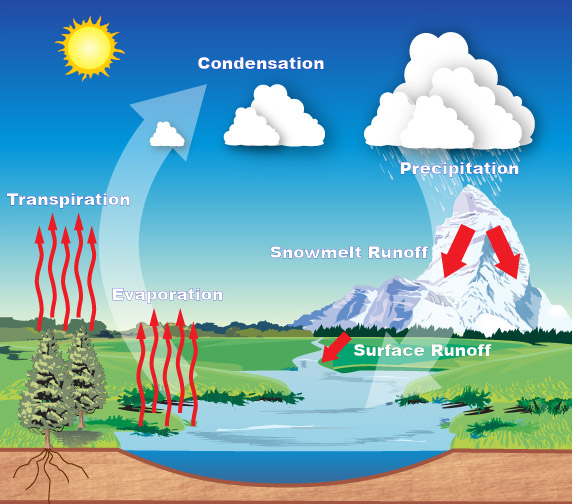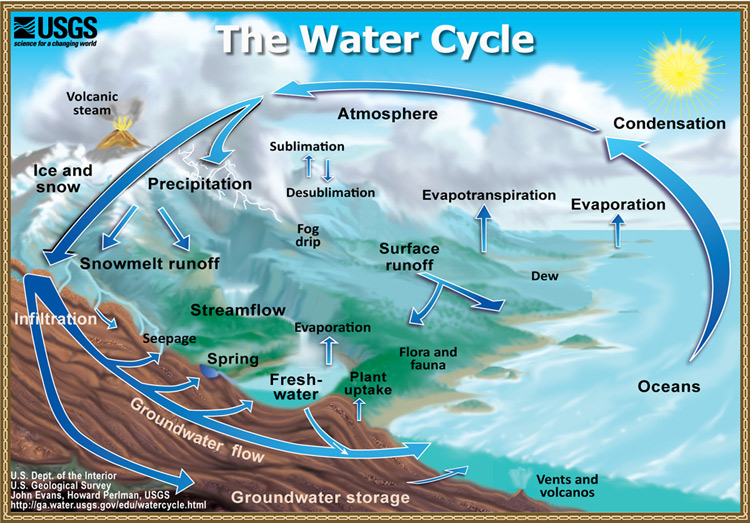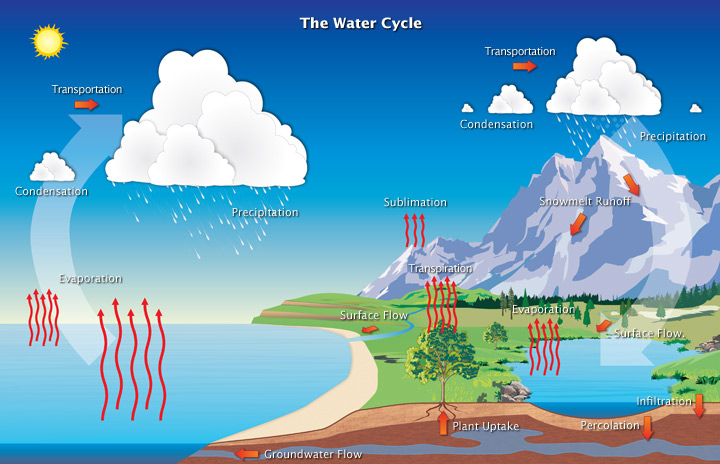Briefly Describe the Movement of Water Through the Water Cycle
What are the four unique chemical properties of water. Evaporation transpiration condensation precipitation and runoff are the most important processes in the water cycle.

Nws Jetstream The Hydrologic Cycle
View the full answer.

. The water cycle begins with surface water which is represented by rivers lakes and oceans. Complex pathways include the passage of water from the gaseous envelope around the planet called the atmosphere through the bodies of water on the surface of earth such as the oceans glaciers and lakes and at the same time or more slowly. During the water cycle water in the water bodies get heated up and evaporates in the form of vapour mixes with the air and disappears.
The continuous movement of water from the surface to clouds and from clouds to the surface is also called as the Hydrologic cycleThe process of the water cycle mainly includes 4 steps they are - Evaporation Condensation Precipitation Runoff and infiltration. Moves through the atmosphere and eventually falls as precipitation. This gigantic system powered by energy from the Sun is a continuous exchange of moisture between the oceans the atmosphere and the land.
The Hydrologic Cycle also called the Water Cycle is the continuous movement of water in the air on the surface of and below the Earth. Rather water from the ocean evaporates in form of gas into the atmosphere as vapor Clouds. The Hydrologic Cycle also called the Water Cycle is the continuous movement of water in the air on the surface of and below the Earth.
Recall there are 5 major processes involved in the hydrologic cycle. Earths water is always in movement and the natural water cycle also known as the hydrologic cycle describes the continuous movement of water on above and below the surface of the Earth. Nitrogen Cycle - is the movement of nitrogen through ecosystems Carbon Cycle - is the flow of carbon as a solid liquid or gas.
Science Earth Science QA Library Briefly describe the water cycle. 131 List the hydrospheres major reservoirs and describe the different paths that water takes through the hydrologic cycle. Its the passage in which water recycles around the Earth.
Surface water also includes the solid forms of water-- snow. Its because water has 3 phases a liquid solid and vapor. When the evaporated water vapour loses its thermal energy it.
The hydrologic cycle describes how water moves continuously in nature. Although the balance of water on Earth remains fairly constant over time individual water molecules can come and go in and out of the atmosphere. Some water evaporates quickly from the surfaces of the plants.
From reservoirs to the air and back on land water is always in motion. The water thats left reaches the soil and in most cases will begin to. The 5 major processes involved are- Evapotranspiration Condensation Precipitation Runoff Infiltration.
Oceans glaciers rivers lakes air soil and living tissue Water evaporates from the ocean plants and soil. Hydrologic cycle has no particular ending or a specific beginning. The water falling on land collects in rivers and lakes soil and porous layers of rock and much of it flows back into the oceans where it will once more evaporate.
Evaporation refers to the movement of water from the Earths surface to the atmosphere. The hydrologic cycle has three main stages. When the rate of rainfall exceeds the Earths ability to absorb it the surplus.
When water condenses it releases energy and warms the environment. When water evaporates it takes energy from the surrounding environment. Water is always changing states between liquid vapor and ice with these processes happening in the blink of an eye and over millions of years.
Water Cycle - is the movement of water through Earths ecosystems. During evaporation the liquid form of water is converted to the gaseous or vapour state. The water moves from one reservoir to another such as from river to ocean or from the ocean to the atmosphere by the physical processes of evaporation condensation precipitation infiltration runoff and.
There are many steps in the water cycle including evaporation transpiration condensation precipitation sublimation. Briefly describe how water moves through the hydrologic cycle. Next it moves through evaporation or the process by which water is converted from its liquid state.
Transpirationis the loss of water through minute pores in the leaves. Freshwater Water Science. Up to 24 cash back The water cycle is also known as the hydrologic cycle.
In land-based or terrestrial ecosystems in their natural state rain usually hits the leaves and other surfaces of plants before it reaches the soil. The same water has been on the earth for millions of years there is never any more or less water. This cycle is the exchange of energy which influences climate.
The process by which water from its liquid state changes to vapour a gaseous state is termed as evaporation. This is the initial stage of the water cycle. Water Cycle - The process of moving the earths water above and below the surface is called the water cycle.
- when water falls on land a portion of the water soaks into the ground slowly moving downward then laterally finally seeping into lakes streams or directly into the ocean. The movement of water. Briefly describe the movement of water through the water cycle.
The water cycle describes how water evaporates from the surface of the earth rises into the atmosphere cools and condenses into rain or snow in clouds and falls again to the surface as precipitation. The water or hydrologic cycle describes the pilgrimage of water as water molecules make their way from the Earths surface to the atmosphere and back again in some cases to below the surface. The global water cycle can be described with nine major physical processes which form a continuum of water movement.
Briefly describe the movement of water through the hydrologic cycle. For each chemical property provide one example that explains its importance to life on Earth. The process by which water from its liquid state changes to vapour a gaseous state is termed as evaporation.

Process Of The Water Cycle From Precipitation To Evaporation Aqwest

Water Cycle New World Encyclopedia

Water Cycle Diagram Water Cycle Diagram Cycle Drawing Water Cycle

The Water Cycle A Guide For Student Apec Water

The Water Cycle In This Simplified Diagram Of The Water Cycle Water Download Scientific Diagram

Hydrologic Cycle Energy Education



No comments for "Briefly Describe the Movement of Water Through the Water Cycle"
Post a Comment